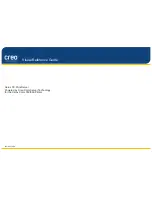
ChannelPort module rear panel
Key
Component
Description
4
External Input 2/External
Fill Input
Use for video input or External Fill input when port
1 is used for Key input.
5
Video Output
(Clean Secondary)
Use for clean secondary video
output.“Clean”output refers to video output with no
graphics or overlays.
6
Video Output
(Clean Primary)
Use for secondary video output or for SD-branded
output when in Independent Branding mode on
Channel B.
7
AES Audio IN
Use for AES input.
8
LTC OUT
Use for LTC output.
9, 10
Reference In and
Reference Loop
Use these connectors to connect reference black
video to the ChannelPort. Reference black video
should be looped through these connectors and
then eventually terminated.
Refer to “About MediaPort module timing” for
additional information.
11
Soft Power button
The
Soft Power
button, in the middle, is a
momentary switch that is used to perform a “soft”
reset of the ChannelPort. Once pressed, all
boards reset and code is re-loaded. The function
is similar to clicking the
Reboot
button on the
SystemManager ChannelPort Properties page.
The Status/Wink LED, on the bottom, is blue to
indicate power is ON. The LED will blink (wink)
when its wink mode is activated.
12
Status/Wink LED
The Status/Wink LED, on the bottom, is blue to
indicate power is ON. This LED can show the
following states:
• Blue, solid: Indicates the unit is powered on.
• Off: Indicates the unit is powered off.
• Blue, blinking: Indicates wink state is on.
For information on changing the wink state,
refer to “Changing the ChannelPort wink state”
in the
Harmonic SystemManager User Guide
.
13
GPIO Connector
This connector can be used for player or
graphics control, or for EAS connection. See
"GPIO connector signal assignments" for signal
assignments.
14
RS-422 Port and LEDs
Use this connector (RJ-45) for RS-422 serial
control. The LED at the top left of the port
indicates channel activity.
173
Spectrum System 8.4 Installation Guide
















































